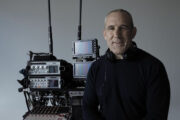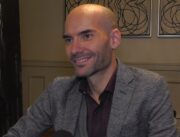Los Angeles, CA, December 1, 2015: Since Nikola Tesla’s early experiments with lighting included producing “a wireless plasma lamp,” The International Press Academy’s namesake Tesla Award In Recognition of Visionary Achievement in Filmmaking Technology for 2015 will go to Hive Lighting, and company co-founders Robert Rutherford and Jon Edward Miller, whose energy efficient, full-spectrum, flicker-free plasma lighting systems are now put to use on Hollywood film sets. While Brown University graduates Rutherford and Miller have been cited for their lighting advances in popular media outlets like WIRED, Los Angeles Times, American Cinematographer, MovieMaker, and Forbes, the story of their “clean-tech company that designs and manufacturers energy efficient Plasma lights for Film, Television, Digital, and Sports productions,” begins with Tesla’s foray into the properties of light.
Fittingly, the movies themselves were first known as “the flickers” for the dancing quality of projected traditional light. Arc lamps that sparked off carbon rods were among the first lighting techniques, an incendiary process that actually caused the images to flit and ‘flicker’ based on this unstable luminous intensity. Since Arc lights and mercury vapor lamps, resulted in dangerous working conditions, alternative methods were needed. Having found success with Alternating Current and many other breakthrough discoveries, Tesla proposed plasma lighting. Plasma Globes, with light generated by radio frequency and electrostatic current, were his initial approach in 1892.
Tesla honoree Hive Lighting’s plasma “is completely flicker-free. Plasma is the world’s most reliable high-speed light source; the process of super-heating the argon gas in each bulb requires cycles well beyond the frame rates currently possible with any high-speed camera. At 450Mhz, a plasma bulb cycles 450 million times per second, the equivalent of 225 million frames per second before any flicker could be detected. The fastest HMIs (Hydrargyrum Medium-Arc Iodide) are usually cycling at 1000hz, or 450,000 times slower per second; even the fastest LEDs are only at 5000hz,” according to their product notes.
Today, as with many of Tesla’s far-reaching insights, the incandescent bulb has been rendered nearly extinct; and plasma lighting has finally come of age in the digital era of filmmaking. Up against Thomas Edison with his much-hyped incandescent lightbulb, Tesla made a bold statement in 1929 for a publication called “The World.” He said, “Surely, my system is more important than the incandescent lamp, which is but one of the known electric illuminating devices and admittedly not the best. Although greatly improved through chemical and metallurgical advances and skill of artisans it is still inefficient… In my opinion, it will soon be superseded by the electrode-less vacuum tube which I brought out thirty-eight years ago, a lamp much more economical and yielding a light of indescribable beauty and softness.”
IPA created the Tesla Award in 2001 to honor game-changing pioneers who continue to influence the way filmed entertainment evolves. Past recipients of the International Press Academy’s Nikola Tesla Award include: Walter Murch, Roger Deakins, Rick Baker, James Cameron, Jerry Lewis, Robert A. Harris, Stan Winston, Richard Donner, Dennis Muren and first honoree, George Lucas. Hive Lighting, and company co-founders Robert Rutherford and Jon Edward Miller join our prestigious roster of recipients.





